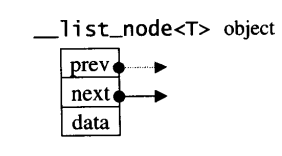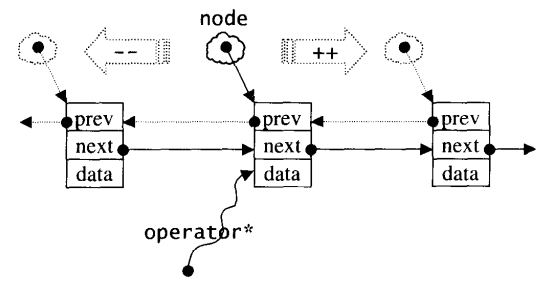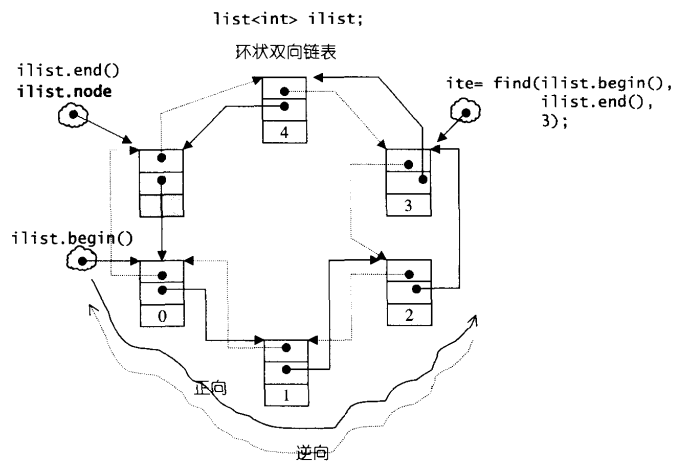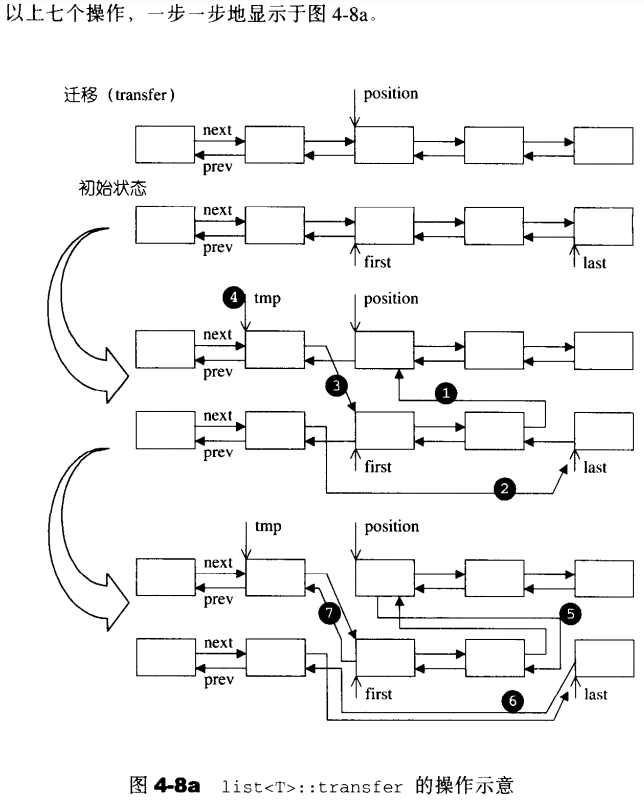STL源码剖析——序列式容器#2 List
list就是链表的实现,链表是什么,我就不再解释了。list的好处就是每次插入或删除一个元素,都是常数的时空复杂度。但遍历或访问就需要O(n)的时间。
List本身其实不难理解,难点在于某些功能函数的实现上,例如我们会在最后讨论的迁移函数splice()、反转函数reverse()、排序函数sort()等等。
list的结点
设计过链表的人都知道,链表本身和链表结点是不一样的结构,需要分开设计,这里的list也不例外,以下是STL list的结点结构:
1 template <class T> 2 struct __list_node { 3 typedef void* void_pointer; 4 void_pointer next; 5 void_pointer prev; 6 T data; 7 };
从结点结构可以看出,list是一个双向链表,有指向前一结点的prev指针,指向下一结点的next指针。

list的迭代器
显然,list的迭代器本身是什么类型早已由其本身的数据结构所决定,list的双向链表,不支持随机存取,只能是双向迭代器(Bidirectional Iterators)。另外,list的迭代器应该支持正确的递增、递减、取值、成员取用等操作。
以下是list迭代器的源码:
1 template<class T, class Ref, class Ptr> 2 struct __list_iterator { // 未继承 std::iterator 3 typedef __list_iterator<T, T&, T*> iterator; 4 typedef __list_iterator<T, const T&, const T*> const_iterator; 5 typedef __list_iterator<T, Ref, Ptr> self; 6 // 未继承 std::iterator,所以必须自行撰写五个必要的迭代器相应类型 7 typedef bidirectional_iterator_tag iterator_category; // (1)双向迭代器类型 8 typedef T value_type; // (2) 9 typedef Ptr pointer; // (3) 10 typedef Ref reference; // (4) 11 typedef __list_node<T>* link_type; 12 typedef size_t size_type; 13 typedef ptrdiff_t difference_type; // (5) 14 link_type node; // node就是一个指向链表节点的指针 15 16 __list_iterator(link_type x) : node(x) {} 17 __list_iterator() {} 18 __list_iterator(const iterator& x) : node(x.node) {} 19 // 迭代器必要的操作 20 bool operator==(const self& x) const { return node == x.node; } 21 bool operator!=(const self& x) const { return node != x.node; } 22 // * 取值符号,data是T类型,而reference是T&,返回reference,说明支持当作左值 23 reference operator*() const { return (*node).data; } 24 #ifndef __SGI_STL_NO_ARROW_OPERATOR 25 //不太能理解 26 pointer operator->() const { return &(operator*()); } 27 #endif /* __SGI_STL_NO_ARROW_OPERATOR */ 28 29 //关键:对迭代器累加 1,就是前进一个节点 30 self& operator++() { 31 node = (link_type)((*node).next); //next为void*,強制转为指向节点的指针类型(__list_node<T>*) 32 return *this; //迭代器对象本身没有前进后退这一说法,前进后退的是隐藏在迭代器里的成员node 33 } 34 self operator++(int) { //后缀++ 35 self tmp = *this; 36 ++*this; 37 return tmp; 38 } 39 // 对迭代器累减 1,就是后退一个节点 40 self& operator--() { 41 node = (link_type)((*node).prev); // 同理 42 return *this; 43 } 44 self operator--(int) { //后缀-- 45 self tmp = *this; 46 --*this; 47 return tmp; 48 } 49 };

于我而言,我觉得都比较容易理解,唯一不太懂的就是operator->()函数,这里讲一下我的理解,但不知道对不对,其返回的是&(operator*()),而operator*()我们知道返回的是data变量的引用,前面有个取址符号&,说明返回的是data变量的地址?然后返回的类型是pointer,即T*,总的来说返回的是一个T类型指针,该指针指向data变量所在的地址?好像合理,那该怎么使用?可能是it->data时我们能继续当它是指针然后it->data->?
list的数据结构
由上述可知,list是一个双向链表,但不仅如此,它还是个环状双向链表,为什么这么设计?因为这样用一个节点指针就能表示整个链表,何为表示整个链表?就是说我们能够从这一个节点出发,顺序遍历整个链表以及逆序遍历整个链表,而非环状不能做到如此,除非用两个节点(一个头、一个尾)才能表示整个链表。双向链表做成环状很简单,我们用一个节点指针指向链表尾部的一个空白结点(也可以说是头部之前的一个空白结点),该空白结点连接了链表的头部和尾部。
1 template <class T, class Alloc = alloc> // 預設使用 alloc 為配置器 2 class list { 3 protected: 4 typedef __list_node<T> list_node; 5 public: 6 typedef list_node* link_type; 7 8 protected: 9 link_type node; // 永远指向最后结点的下一节点。该结点无元素值,代表空节点。 10 // 其 next 节点永远是头节点 11 };
这可能会有疑问,为什么不让首尾直接相连,而要隔一个空白结点呢?因为有一个空白结点,符合STL对于区间“前闭后开[, )”的要求,成为last迭代器所指。这么一来,一些功能函数的设计就变得很简单:
1 iterator begin() { return (link_type)((*node).next); } 2 const_iterator begin() const { return (link_type)((*node).next); } 3 4 iterator end() { return node; } 5 const_iterator end() const { return node; } 6 7 bool empty() const { return node->next == node; } 8 size_type size() const { 9 size_type result = 0; 10 distance(begin(), end(), result); 11 return result; 12 } 13 14 // 取头节点的內容(元素值)。 15 reference front() { return *begin(); } 16 const_reference front() const { return *begin(); } 17 // 取尾节点的內容(元素值)。 18 reference back() { return *(--end()); } 19 const_reference back() const { return *(--end()); }

list的构造与内存管理
与Vector类似,list也定义了一个simple_alloc<>对象来负责空间配置事宜,其第一个类型参数为结点类__list_node<T>,为的是每次都分配一个节点大小的空间,第二个类型参数为alloc空间配置器。
1 template <class T, class Alloc = alloc> // 预设使用alloc为配置器 2 class list { 3 protected: 4 typedef void* void_pointer; 5 typedef __list_node<T> list_node; 6 // 专属分配空间的对象,每次配置一个节点的大小 7 typedef simple_alloc<list_node, Alloc> list_node_allocator;
以下4个函数分别用来配置、释放、构造、销毁一个节点:
1 protected: 2 // 配置一个节点并将其返回 3 link_type get_node() { return list_node_allocator::allocate(); } 4 // 释放一个节点 5 void put_node(link_type p) { list_node_allocator::deallocate(p); } 6 // 构造一个节点(配置空间并赋予值)并返回 7 link_type create_node(const T& x) { 8 link_type p = get_node(); 9 __STL_TRY{ 10 construct(&p->data, x); 11 } 12 __STL_UNWIND(put_node(p)); 13 return p; 14 } 15 // 摧毁一个节点(析构并释放) 16 void destroy_node(link_type p) { 17 destroy(&p->data); 18 put_node(p); 19 }
list提供了很多种构造函数,第一个就是默认构造函数,允许我们不指定任何参数而创建一个空的list:
1 public: 2 list() { empty_initialize(); } // 产生一个空链表 3 protected: 4 void empty_initialize() { 5 node = get_node(); // 配置一个节点空间,令 node 指向它。为空白节点 6 node->next = node; // 令 node 头尾都指向自己,不设元素值。 7 node->prev = node; 8 }
第二个就是比较常用的,构造n个值为value的节点,第三个就是构造n个结点,内容用T类型的默认构造函数填充,两个构造函数虽然用法不一,但实际上都转调用了同一个函数:
1 public: 2 list(size_type n, const T& value) { fill_initialize(n, value); } 3 list(int n, const T& value) { fill_initialize(n, value); } 4 list(long n, const T& value) { fill_initialize(n, value); } 5 explicit list(size_type n) { fill_initialize(n, T()); } 6 protected: 7 void fill_initialize(size_type n, const T& value) { 8 empty_initialize(); 9 __STL_TRY{ 10 insert(begin(), n, value); 11 } 12 __STL_UNWIND(clear(); put_node(node)); 13 }
对就是fill_initialize(),而fill_initialize()自己也精明的很,我就创建一个空链表,然后就撒手不管了,全交给insert()函数,能看出这样能把构造变成原子操作,能就n个节点全部构造好,不然就一个都不构造。另外,在push_back()函数里也是把自己的工作外包了给insert()函数,可见insert()函数承担了太多,当然我们会在稍后重点学习Insert()函数。
1 // 安插一个节点,做为头节点 2 void push_front(const T& x) { insert(begin(), x); } 3 // 安插一个节点,做为尾节点 4 void push_back(const T& x) { insert(end(), x); }
insert()具有多个版本,其中最简单的一种,就是在指定位置插入一个节点:
1 // 在迭代器 position 所指位置安插一個节点,內容为 x。 2 iterator insert(iterator position, const T& x) { 3 link_type tmp = create_node(x); // 产生一个节点(值为x) 4 // 调整前后指针,使 tmp 安插进去。 5 tmp->next = position.node; 6 tmp->prev = position.node->prev; 7 (link_type(position.node->prev))->next = tmp; 8 position.node->prev = tmp; 9 return tmp; 10 }
而其余的版本都是在反复调用上面这个版本罢了:
1 template <class T, class Alloc> 2 void list<T, Alloc>::insert(iterator position, size_type n, const T& x) { 3 for (; n > 0; --n) 4 insert(position, x); 5 } 6 template <class T, class Alloc> 7 void list<T, Alloc>::insert(iterator position, 8 const_iterator first, const_iterator last) { 9 for (; first != last; ++first) 10 insert(position, *first); 11 } 12 template <class T, class Alloc> 13 void list<T, Alloc>::insert(iterator position, const T* first, const T* last) 14 { 15 for (; first != last; ++first) 16 insert(position, *first); 17 } 18 void list<T, Alloc>::insert(iterator position, 19 InputIterator first, InputIterator last) { 20 for (; first != last; ++first) 21 insert(position, *first); 22 }
所谓的插入,就是指 指定位置的前方,这是STL的插入规范。另外,不像vector,list所有的插入操作都不会影响现有迭代器的有效性。

list的元素操作
- erase(iterator position) —— 移除迭代器position所指节点
1 iterator erase(iterator position) { 2 //断开当前节点连接,并将前后节点相连 3 link_type next_node = link_type(position.node->next); 4 link_type prev_node = link_type(position.node->prev); 5 prev_node->next = next_node; 6 next_node->prev = prev_node; 7 destroy_node(position.node); 8 return iterator(next_node); 9 }

- pop_front() —— 移除头节点
1 void pop_front() { erase(begin()); }
- clear() —— 清除所有节点(整个链表)
1 template <class T, class Alloc> 2 void list<T, Alloc>::clear() 3 { 4 link_type cur = (link_type)node->next; // 切记,list类内有一node节点指针指向链表末尾的空白结点,这里就是begin() 5 while (cur != node) { // 遍历链表 6 link_type tmp = cur; 7 cur = (link_type)cur->next; 8 destroy_node(tmp); // 逐一摧毁节点 9 } 10 // 恢復 node 原始狀態 11 node->next = node; 12 node->prev = node; 13 }
- remove(const T& value) —— 将值为value的所有元素移除
1 template <class T, class Alloc> 2 void list<T, Alloc>::remove(const T& value) { 3 iterator first = begin(); 4 iterator last = end(); 5 while (first != last) { // 遍历链表 6 iterator next = first; 7 ++next; //next指针负责前进一格,并与之比较 8 if (*first == value) erase(first); // 找到就移除 9 first = next; 10 } 11 }
- unique() —— 移除值相同的连续元素,只有相同且连续的元素才会被移除,移除剩一个
1 template <class T, class Alloc> 2 void list<T, Alloc>::unique() { 3 iterator first = begin(); 4 iterator last = end(); 5 if (first == last) return; 6 iterator next = first; 7 //next前进一格探路,相同排掉,不同叫first跟上 8 while (++next != last) { 9 if (*first == *next) 10 erase(next); 11 else 12 first = next; 13 next = first; 14 } 15 }
比较难的几个函数来了,相比于上面这些小打小闹的弟弟,这些函数确实不易理解,尤其是排序函数sort(),其高超的算法逻辑使我瞠目结舌,作者造轮子的能力太强了。
- transfer(iterator position, iterator first, iterator last) —— 将[first, last)内的所有元素移动到position之前。
1 protected: 2 void transfer(iterator position, iterator first, iterator last) { 3 if (position != last) { 4 //处理各节点的next 5 (*(link_type((*last.node).prev))).next = position.node; // (1) last的上一结点(next)与position相连 6 (*(link_type((*first.node).prev))).next = last.node; // (2) first的上一节点(next)与last相连 7 (*(link_type((*position.node).prev))).next = first.node; // (3) position的上一节点(next)与first相连 8 9 link_type tmp = link_type((*position.node).prev); // (4) 用一节点指针记录position的上一节点tmp,因为下一步position的上一节点就应该是last的上一节点了 10 11 //处理各节点的prev 12 (*position.node).prev = (*last.node).prev; // (5) position(prev)与last的上一节点相连 13 (*last.node).prev = (*first.node).prev; // (6) last节点(prev)与first的上一节点相连 14 (*first.node).prev = tmp; // (7) first节点(prev)与原是position上一节点的节点tmp相连 15 } 16 }

要注意的是,transfer所接受的区间是没有限制的(从源码也可以看出),这意味着[first, last)与position可以来自同一个链表,甚至position就在[first, last)区间内都行,只是从结果来看前者还能得到想要的答案,后者就有点奇怪了。
从protected可知,我们并不能直接使用transfer,而是使用到transfer的公开接口为:
- splice(iterator position, list& x) —— 将x接合与position所指位置前,注意x必须不同于*this(调用者本身),将自身链表接合在自身链表的某一位置上毫无意义。
1 void splice(iterator position, list& x) { 2 if (!x.empty()) 3 transfer(position, x.begin(), x.end()); 4 }
- splice(iterator position, list&, iterator i) —— 将 i 所指元素接合于position所指位置之前,position与 i 可来自于同一链表
1 void splice(iterator position, list&, iterator i) { 2 iterator j = i; 3 ++j; 4 if (position == i || position == j) return; //position == j 说明i已经在position前面了 5 transfer(position, i, j); //[i, j) 6 }
- merge(list<T, Alloc>& x) —— 将 x 合并到*this身上。两个lists的内容都必须经过递增排序,注意,这是链表自底向上归并排序用到的重要函数。
1 template <class T, class Alloc> 2 void list<T, Alloc>::merge(list<T, Alloc>& x) { 3 iterator first1 = begin(); 4 iterator last1 = end(); 5 iterator first2 = x.begin(); 6 iterator last2 = x.end(); 7 // 注意:前提是,兩个 lists 都已经过递增排序, 8 while (first1 != last1 && first2 != last2) 9 if (*first2 < *first1) { 10 iterator next = first2; 11 transfer(first1, first2, ++next); //[first2,++first2) 放在first1所指位置的前面 12 first2 = next; 13 } 14 else 15 ++first1; 16 if (first2 != last2) transfer(last1, first2, last2); //如果first1已经到尾而first2还有,将剩下的全部放到first1后面 17 }
- reverse() —— 反转链表
1 template <class T, class Alloc> 2 void list<T, Alloc>::reverse() { 3 // 以下判断,如果是空白链表,或仅有一个元素,就不做任何动作。 4 // 使用 size() == 0 || size() == 1 來判断,虽然也可以,但是比较慢。 5 if (node->next == node || link_type(node->next)->next == node) return; 6 iterator first = begin(); 7 ++first; 8 while (first != end()) { 9 iterator old = first; 10 ++first; 11 transfer(begin(), old, first); //逐个元素往链表头前面移动,最终反转 12 } 13 }
因为STL的算法sort()只接受随机迭代器(Random Access Iteartor),但list只有双向迭代器(Bidirectional Iterator),所以不能使用,为此STL为list设计了专有的sort(),侯捷老师书上说该函数使用了quick sort,但我觉得它更像是merge sort。因为丝毫没有快排的特征。存疑。
1 template <class T, class Alloc> 2 void list<T, Alloc>::sort() { 3 // 以下判断,如果是空白链表,或仅有一个元素,就不做任何动作。 4 if (node->next == node || link_type(node->next)->next == node) return; 5 // 我们应该知道,归并排序一般需要一个临时数组来存放合并后的数据 6 list<T, Alloc> carry; 7 list<T, Alloc> counter[64]; //这个就是临时数组,第i个链表存放2的i次方个数据,设计者认为64次合并已经是足够大了,毕竟2的64次方是个很大的数据量了。 8 int fill = 0; 9 while (!empty()) { 10 carry.splice(carry.begin(), *this, begin()); //只要调用者的链表非空,就将链表的头节点移动到carry里面,每次就移一个节点,就是头节点。注意由transfer源码知,是移动而非复制 11 int i = 0; 12 //i每次从0开始,这说明每次都会按顺序遍历counter的各个连续非空链表,空就退出 13 //进入到循环,意味着counter[i]非空 14 //而carry绝不会为空,因为从循环内得知,先把carry数组合并到counter[i]里,然后又把它放回carry里,所以carry绝非空 15 //从循环内的carry.swap(counter[i++])得知carry存放的都是上一个counter数据(因为是先swap再自增i再进入下一循环),而counter[i]只要是非空,里面存放的数据量肯定就是2的i次方 16 //carry存放的也是2的i次方的数据量,而counter[i]本身也存放了2的i次方的数据量,两者一合并,就变成了2的i+1次方的数据量,已经大于counter[i]所能存放的数据量,所以把它转回到carry里,在下一循环中放到下一个counter链表中(也即是counter[i++],这也解释了为什么本次循环中carry存放的也是2的i次方的数据量,因为该数据来自上一次循环的counter[i-1]) 17 while (i < fill && !counter[i].empty()) { 18 counter[i].merge(carry); 19 carry.swap(counter[i++]); 20 } 21 //22 23 //这里有两个作用 24 //1.是因为i == fill而终止的循环,此时counter[i]肯定为空(在此之前从未使用过counter[fill]),而carry肯定有数据(来自counter[i-1]),把carry数据转给空的counter[i],此时counter[i]的数据量为2的i次方 25 // 为什么是2的i次方,是因为i == fill而终止的循环,代表count[i-1]放的数据已经超过2的i-1次方,所以转给carry,并把i自增,终止循环,才能给到counter[i] 26 //2.是因为counter[i]为空而终止的循环,将存放在carry的来自上一个counter的数据转给counter[i], 27 carry.swap(counter[i]); 28 //fill代表的是目前开放的最大counter,只有i==fill才自增,而其上一句是carry.swap(counter[i]);将carry的数据转到counter[fill]里,说明只有当counter[fill]有数据了,fill才自增(才开放下一个counter) 29 //如果i没到fill,说明目前从调用者链表里拿的数据量还不足2的fill次方。不足以开放下一个counter。 30 if (i == fill) ++fill; 31 } 32 for (int i = 1; i < fill; ++i) 33 counter[i].merge(counter[i - 1]); 34 swap(counter[fill - 1]); 35 }
我真的很想把这段代码用文字的方式解释清楚,我尽力了,但还是太难了,上面的注释看得懂最好,看不懂最好自己用数据走一下这个函数的流程,大概就能懂了。我对这段代码真是佩服得五体投地。是真的只可意会不可言传。



 浙公网安备 33010602011771号
浙公网安备 33010602011771号